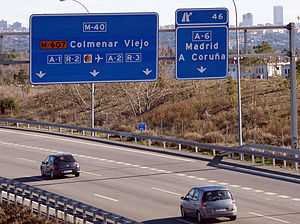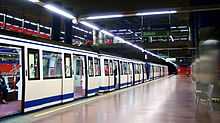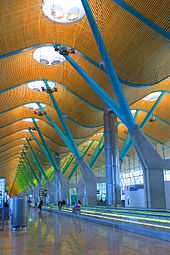Transport in Madrid
Madrid is served by highly developed transport infrastructure. Road, rail and air links are vital to maintain the economic position of Madrid as a leading centre of employment, enterprise, trade and tourism, providing effective connections with not only other parts of the region, but also the rest of Spain and Europe as a whole. Three quarters of a million people commute into the city to work,[1]:66 and these and other local travellers have available a high-capacity metropolitan road network and a well-used public transport system based on the Metro, the Cercanías local railways, and a dense network of bus routes.[1]:62–4
In terms of longer-distance transport, Madrid is the central node of the system of autovías and of the high-speed rail network (AVE), which has brought major cities such as Seville and Barcelona within 2.5 hours travel time.[1]:72–75 Madrid is also home to the Madrid-Barajas Airport, the fourth largest airport in Europe.[1]:76–78 Madrid’s location at the centre of the peninsula makes it a major logistical base.[1]:79–80
Local transport
744,000 of the jobs in the city are held by residents of other municipalities, while 242,000 residents in the capital have jobs outside. Thus passenger flows are predominantly into and out of the city centre, although further decentralisation of economic activity to the outskirts is altering this pattern.[1]:66
From the point of view of sustainable transport, Madrid has performed well from the compactness of the city centre and middle-to-high-density peripheral nuclei, favouring public transport and pedestrian movement. The weak points appear in the “new peripheries”, with low-density residential developments and dispersal of journey destinations, leading to higher car use.[1]:64
Road
The outward expansion of Madrid after 1960 was supported by a growing network of radial roads. Above all these enabled commuter movements to the city centre. It also became necessary to create the first orbital autovía, the M30, which was intended to facilitate the passage of long-distance traffic, but became invaded by local traffic. The scheme implemented at the end of the 1980s consisted of nine radial autovías (those toward Burgos, Barcelona, Valencia, Andalucía, Toledo, Fuenlabrada, Extremadura, La Coruña and Colmenar Viejo) but just the one orbital route – the M-30. Three further orbital routes, each at a greater distance from the centre, were added in the 1990s and 2000s. These are designated M40, M45 and M50.[1]:62–63
The most recent big scheme was improvement of the M30. This road is the inner ring motorway of Madrid. Significant portions of M30 run underground and its urban motorway tunnels have sections of more than 6 km (3.73 mi) in length and 3 to 6 lanes in each direction. Between the south entry of the Avenida de Portugal tunnel and the north exit of the M-30 south by-pass there are close to 10 km (6.21 mi) of continuous tunnels. M40 is a ring motorway which borders Madrid at a mean distance of 10.07 kilometres (6.26 mi) and it has a total length of 63.3 km (39.33 mi). M45 is a partial ring around the city serving the metropolitan area of Madrid. It was built to help alleviate the congestion of the M40 from the southern to the north-eastern, runs between the M40 and the M50 where the two ring motorways are more separated. M50 is the outer of the Madrid orbital motorways and has a total length of 85 km (52.82 mi). It services mainly the metropolitan area at a mean distance of 13.5 km (8.39 mi).
The most important radial autovías of Madrid are:


| Signal | Denomination | Itinerary |
|---|---|---|
| A-1 | Autovía del Norte | Madrid – Aranda de Duero – Burgos – Miranda de Ebro – Vitoria – San Sebastián |
| A-2 | Autovía del Nordeste | Madrid – Guadalajara – Zaragoza – Lérida – Barcelona |
| A-3 | Autovía del Este | Madrid – Valencia |
| A-4 | Autovía del Sur | Madrid – Córdoba – Sevilla – Jerez – Cádiz |
| A-5 | Autovía del Suroeste | Madrid – Talavera de la Reina – Navalmoral de la Mata – Mérida – Badajoz – Portugal |
| A-6 | Autovía del Noroeste | Madrid – Medina del Campo – Benavente – Astorga – Ponferrada – Lugo – A Coruña |
| A-42 | Autovía de Toledo | Madrid – Illescas – Toledo |
More recently, four new radial tolled autopistas (named R-n instead of A-n), listed below, form a new mode of access to the capital, merging with their autovía counterparts further from Madrid. The main advantage to these roads is that they allow true fast travel from the first kilometer. These, however, have frequently been under-utilised, especially after the economic crisis of 2008.[1]:63
| Signal | Denomination | Itinerary |
|---|---|---|
| R-2 |
Autopista Radial 2 | Madrid (M-40)—M-50—Guadalajara (A-2) |
| R-3 |
Autopista Radial 3 | Madrid (M-30)—Arganda del Rey (A-3) |
| R-4 |
Autopista Radial 4 | Madrid (M-50)—Aranjuez—Ocaña (A-4/A-40/AP-36) |
| R-5 |
Autopista Radial 5 | Madrid (M-40)—Navalcarnero (A-5) |
| M-12 |
Eje aeropuerto | Madrid (M-40)—M-11—Airport terminal 4—A-1 |
The investment in roads has resulted in a high-capacity metropolitan road network, facilitating communications between the outer municipalities, and resilient against closures due to works or accidents. However, the new orbital roads have favoured the dispersion and fragmentation of residential areas and areas of economic activity, resulting in an array of urban developments separate from each other, and very dependent on private vehicles.[1]:63
Public transport
Madrid has built up an excellent public transport system, the fruit of long-term policies supporting the extension of the metro and Cercanías networks, the improvement of bus networks, the construction of 28 transport interchanges, and subsidies to public transport. Almost half the journeys by mechanical means in the metropolitan area are made on public transport, a very high proportion compared with most European cities.[1]:64
A mobility survey in 2004 counted 14.5M journeys per day in the region, of which 10.0M were mechanised. 48.6% of the latter took place entirely within the city, 22.5% started or finished in the city, and 28.9% were entirely outside the city. Public transport was used for 69.1% of journeys within the central area, down to 27.3% in the outer periphery (corona regional). Metro accounted for 40% of journeys by public transport, bus 30%, interurban buses 10%, and Cercanías 10%.[1]:65 More recent figures, for 2013, show passengers carried annually by bus 404M, Metro 563M, Cercanías 153M.[2]:49 The inner city relies for transport mainly on the Metro and the EMT bus service. As regards the periphery, public transport is based above all on the Cercanías and interurban buses. The metro, too, is extending into parts of the outer area.[1]:64
Metro


Serving a population of some five million, the Madrid Metro (Metro de Madrid) is one of the most extensive and fastest-growing metro networks in the world.[3] With the addition of a loop serving suburbs to Madrid's south-west "Metrosur", it is now the second largest metro system in Western Europe, second only to London's Underground. In 2007 Madrid's metro system was expanded and it currently runs over 287 kilometres (178 mi) of line.
The system is the sixth longest metro in the world after London, New York, Moscow, Seoul and Shanghai, though Madrid is approximately the fiftieth most populous metropolitan area in the world. Its fast growth in the last 20 years has also put it among the fastest growing networks in the world, on par with the Shanghai Metro and the Beijing Subway. Unlike normal Spanish road and rail traffic, Madrid Metro trains use left-hand running on some lines due to historical reasons.
The metro network consists of 238 stations. It has 12 lines, plus four “light metro” lines recently added. The network consists of diametrical lines, interconnected by one circular line (Line 6). It gives good coverage of much of the municipality – about 50% of the population live within 600m of a metro station.[1]:64
Buses
This railway network is supported by an ever-expanding network of city buses. The overall length of the bus network of Madrid's Municipal Transport Corporation (Empresa Municipal de Transportes, or EMT) at the end of 2013 stood at 3,690 km (2,293 mi), marking a 31% increase over the last eight years. These routes are serviced by a growing fleet of over 3,000 vehicles. The EMT network is very dense, with 217 routes and over 10,000 stops, and almost all the population of the municipality lives within 300m of a bus stop.[1]:64 The buses in Madrid are the only public transport system available 24hours as the metro network closes down during night hours. The night buses, also known as "Buhos" (Owls), run from 11.45pm to 6.00am.[4] The heavy traffic in Madrid can in some cases make the city buses a fairly slow form of transportation but the city of Madrid has more than 90 km of special bus and taxi lines to help solve this issue.[5] Buses serving the outer areas are run by 33 private companies, coordinated by the Consorcio de transportes. This network is fundamentally radial.[1]:64
Local rail
Spain's railway system, the Red Nacional de Ferrocarriles Españoles (RENFE) operates the vast majority of Spain's railways. Cercanías Madrid is the commuter rail service that serves Madrid and its metropolitan area. It is operated by Cercanías Renfe, the commuter rail division of Renfe. The total length spans 382 kilometres (237.4 miles). Main rail terminals are Atocha in the south and Chamartín in the north. The Cercanías network consists of 9 lines and 98 stations.[1]:64
Long-distance transport
Although distant from other great centres of the EU, modern transport links are lessening this disadvantage. There has been large investment in transport infrastructure focussing on Madrid, including radial autovías, high-speed rail, and Madrid-Barajas airport.[1]:70
Road
As noted above, Madrid is the focal point of the high-capacity autovía network, linking it with most parts of the country as well as France and Portugal. The road network is now regarded as largely complete, with attention turning to maintenance and road safety.[1]:72–73
High-speed rail
.jpg)
Madrid ranks alongside Tokyo and Paris as one of the world's three largest high-speed railway hubs, acting as the focal point of the Spanish high-speed rail network, Alta Velocidad Española (AVE), inaugurated in 1992 with the opening of the Madrid-Seville line. There are now 2,900 km of AVE track, connecting Madrid with Barcelona, Málaga, Seville, Valencia, Valladolid, Zaragoza and 11 other provincial capitals. A tunnel has been constructed between the two terminal stations of Atocha and Chamartín, and Atocha has been expanded. The radial character and great extension of the AVE network confer on Madrid exceptional accessibility by rail: the journey time is only 2 hours 30 minutes to Barcelona and Seville. Connection from Madrid by AVE will further increase due to lines under construction to Galicia, Asturias, País Vasco, Alicante, Murcia and Extremadura.[1]:74 About 23M passengers used the AVE in 2011. AVE has taken a large share of travel on the routes served: since the opening of the line to Seville, journeys by train between the two places increased from 14% to 50%, while air fell from 11% to 4% and road from 75% to 46%.[1]:75–76
Rail freight
The Yiwu - Madrid Railway line is the longest cargo goods railway line in the world, at 8,111 miles. It connects the Spanish capital to France, Germany, Poland, Belarus, Russia, Kazakhstan and China.[6][7]
Air

Madrid–Barajas Airport (Aeropuerto de Madrid-Barajas) is Spain's busiest airport, and is the main hub of Iberia Airlines. Important to the city's economy as the largest business in Madrid, estimated to generate 44,000 jobs directly and 210,000 indirectly,[1]:76 it serves as the main gateway to the Iberian peninsula from Europe, America and the rest of the world. In 2013 Barajas handled 39.74M passengers (down 20% from a peak of 49.87M in 2011),[8] of whom 70% were international travellers, in addition to 343.62M tonnes of freight.[2]:48 The passenger volumes make it Spain's largest and busiest airport, and in the same year it was the world's 29th busiest airport and Europe's sixth busiest airport. Air freight movements through Barajas are 52% those of all Spain, and 83.4% of international air freight.[1]:78 A new fourth terminal has been constructed, which has significantly reduced delays and doubled the capacity of the airport to more than 70 million passengers per year. Two additional runways have also been constructed, making Barajas a fully operational four-runway airport that can handle 120 flights per hour.[1]:77
The airport is located within the city limits of Madrid, at 9 km (5.6 mi) from the city's financial district and 13 km (8.1 mi) northeast of the Puerta del Sol, Madrid's historic centre. It has good connections with the city centre by autovía, Cercanías and Metro. The airport name derives from the adjacent district of Barajas, which has its own metro station on the same rail line serving the airport.
The closed Ciudad Real Central Airport was intended to be the second airport for the city, linked to it by high speed rail.
Logistical platform
The region concentrates 54% by value of the national transport of goods & logistical operations, employing 122,000. Favoured by central position, radiality of road & rail routes, importance of the airport, As well as being a large centre of production and consumption, it is a great distribution centre. The municipality concentrates two-thirds of the region’s employment in the sector, but this is becoming more decentralised. A regional plan seeks to create nine new logistical centres outside the city, in order to decongest the central areas and rationalise distribution chains.[1]:79–80
References
- ↑ 1.0 1.1 1.2 1.3 1.4 1.5 1.6 1.7 1.8 1.9 1.10 1.11 1.12 1.13 1.14 1.15 1.16 1.17 1.18 1.19 1.20 1.21 1.22 1.23 1.24 Estructura Economica de le Ciudad de Madrid, Ayuntamiento de Madrid (Madrid City Council), August 2013
- ↑ 2.0 2.1 Barómetro de Economía de la Ciudad de Madrid, No. 41, Ayuntamiento de Madrid (Madrid City Council), October 2014
- ↑ "Madrid Metro". Robert Schwandl. 17 August 2006.
- ↑ "Public Transportation in Madrid". .madrid-university.es.
- ↑ "Bus lines in Madrid". ecomovilidad.net.
- ↑ "China flags train to Madrid to revive Silk Route", Atul Aneja, The Hindu, 23 November 2014
- ↑ "The Silk Railway: freight train from China pulls up in Madrid", Guardian, 10 December 2014
- ↑ Spain AENA Airport Statistics
